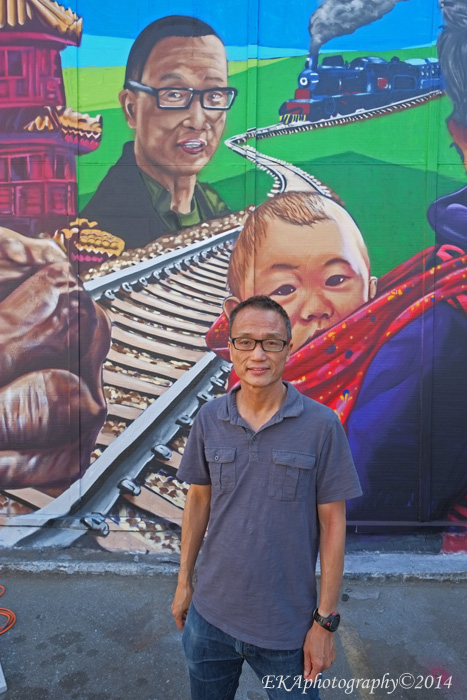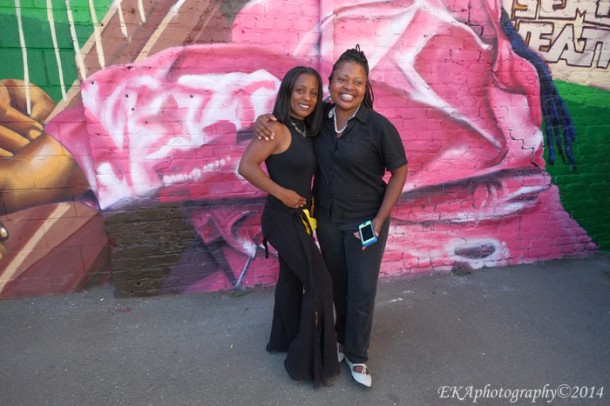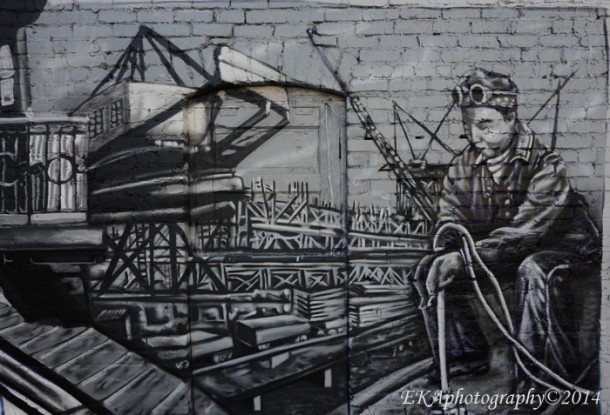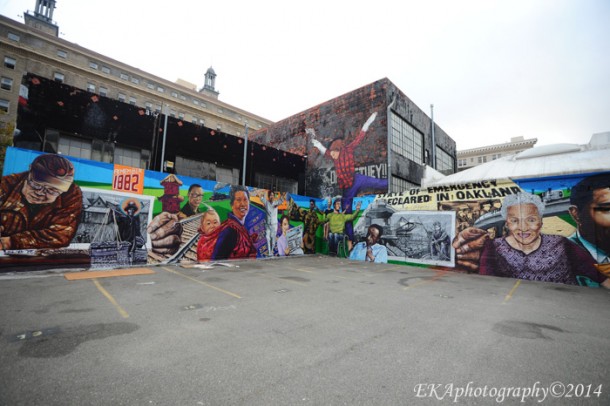
photo by Eric K. Arnold/EKAphotography
Recently, CRP pulled off a pretty cool feat: within the course of ten days, the Alice Street Mural Project received media hits from the Mercury News , Oakland Tribune, KQED, Oakland Mayor Jean Quan’s newsletter, Oakland Tribune (again), and the Contra Costa Times. That’s easily the most attention from local media CRP has ever gotten for any of the 150 mural projects the organization has done in the past four years.
Even more impressive was what the media had to say about the project. Writing for the Tribune, Samantha Clark said, “Chinese dragons, African dancers, protests and historical scenes take shape in vibrant colors on once-blighted walls surrounding a parking lot. The Alice Street Mural Project is a mural and documentary about the intersection of cultures at 14th and Alice streets in downtown Oakland.The stories that documentarian Spencer Wilkinson and artists Desi Mundo and Pancho Peskador tell celebrate the Chinese and African-American residents’ history and resilience against displacement.” Clark’s article was accompanied by three full-color photos of Phase I’s three walls, with interactive multimedia identifying the historical figures—some of whom are still living—depicted in the mural.

Photo by Eric K. Arnold/EKAphotography
For KQED’s Visual Arts blog, writer Ben Valentine took a personal approach. “I was taken by the beautiful colors, the personalities depicted, and also how many people were stopping to photograph the mural and talk with the artists. I’ve spent a long time in museums and galleries, so unexpectedly stumbling across such a lively piece was quite a joy for me. Seeing the community come out to watch the process unfold was exciting,” he said.
Valentine also recounted the mural creation process, which involved a great deal of community outreach, engagement, and input, as it unfolded over the course of a year: “Seeking how to best make a mural for the location, CRP leafleted, interviewed residents, showed up at community events, and more. CRP wanted the people who would be walking by this mural most often to tell them who to feature on the wall.”
As noted in a previous CRP blog post, the mayor took special interest in the mural, which spoke to her history as a fourth-generation Oaklander and Chinese-American. As her newsletter stated, “the Alice Street Mural was created with community input to reflect the diversity of that specific corner of the city. The large and diverse crowd at the ribbon-cutting ceremony included residents from nearby Chinatown and the California Hotel on 14th Street and the performing arts community of the Malonga Casquelourd Center for the Arts on Alice Street. These people reflect the subject matter of the mural’s many figures and illustrations.”

photo by Eric K. Arnold/EKAphotography
The post went on to describe the mural: “There is a dance wall depicting the incredible dance scene at the Malonga Casquelourd Center, including images of Congolese dance great, the late Malonga Casquelourd and Dance-A-Vision founder Carla Service. One wall illustrates stories about workers: the 1946 Oakland General Strike, the “Rosie the Riveter” shipyard workers of WWII, the Pullman Porters who served aboard the Southern Pacific Railroad line. These individuals reflect the political influence of Oakland on the nation’s history. A third wall depicts the history of Chinese Americans in Oakland (and) the importance of 1882 in our history and the passage of the Chinese Exclusion Act, restricting immigration from China and separating families.”
Tribune writer Annalee Allen attended the ribbon-cutting ceremony and also noted individual portraits of Chinatown historian Roy Chan and Bay Area broadcast journalist Jerri Lange, as well as the history of the two buildings around which the mural concept was centered. “Both the Malonga Casquelourd Center for the Arts, built in 1928 and the Hotel Oakland, built in 1912, are local historical landmarks that have been adapted to new uses. The arts center started out as the Oakland Women’s City Club and was home to a number of women’s clubs and associations. History files describe the era leading up to the club’s opening the 1920s as the time following women successfully gaining the right to vote. The Hotel Oakland opened soon after the 1906 earthquake, when San Francisco was still rebuilding and Oakland was experiencing an economic boom.”

Photo by Eric K. Arnold/EKAphotography
CRP is deeply appreciative of the media recognition and support, and it is the organization’s hope that this mural might represent a turning point for both public art in Oakland and public perception of the aerosol artform. Legitimate muralists who use the spray paint medium are often lumped in with rogue vandals who deface property without permission, lack the technical skills necessary to do large-scale murals, and don’t engage the community or seek input before painting.
For quite some time, CRP has been saying that murals are not only an effective abatement strategy, and a viable alternative to simply buffing walls only to have them tagged again (and again), but a better solution than simple abatement, in terms of cost-effectiveness, long-term durability, and community benefit. The Alice Street Mural – and all the positive press around the project – validates this belief. Moving forward, we hope the success of this project will lead to more large-scale murals being commissioned in high-visibility, high-blight areas.

photo by Eric K. Arnold/EKAphotography
